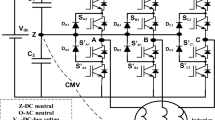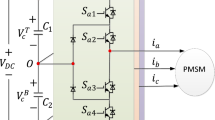Abstract
Three-level inverters offer several advantages, including reduced harmonic distortion in output currents and alleviated voltage stress on power electronic devices. However, the imbalance of the neutral point potential causes distortion in the output voltage if not considered during calculations. In the present paper, a model that incorporates the impact of neutral point imbalance on the output voltage is proposed, thereby enhancing the accuracy of current trajectory predictions. Additionally, the model features a dynamic compensation of the output voltage. To achieve a balance between neutral point potential symmetry and switching frequency, constraints are applied to limit the neutral point potential within a specific range. Simulation and experimental results underscore the effectiveness of the presented control scheme.

















Similar content being viewed by others
Availability of data and materials
The data presented in this study are available on request from the corresponding author.
References
Geyer T (2011) A comparison of control and modulation schemes for medium-voltage drives: emerging predictive control concepts versus PWM-based schemes. IEEE Trans Ind Appl 47(3):1380–1389. https://doi.org/10.1109/TIA.2011.2127433
Mertens A, Sommer R, Brunotte C (2000) Applications of medium voltage drives with IGBT three-level inverter. IEE seminar PWM medium voltage drives (Ref. No. 2000/063), Birmingham, UK, pp 7/1–7/4. https://doi.org/10.1049/ic:20000339
Holtz J, Stadtfeld S (1983) A predictive controller for the stator current vector of AC machines fed from a switched voltage source. In: Proceedings of the international power electronics conference, Japan. IEEE, pp 1665–1675. Accessed 18 May 2023
Nasiri MR, Farhangi S, Rodríguez J (2019) Model predictive control of a multilevel CHB STATCOM in wind farm application using Diophantine equations. IEEE Trans Ind Electron 66(2):1213–1223
Holtz J (2016) Advanced PWM and predictive control—an overview. IEEE Trans Ind Electron 83(6):3837–3844
Chen X, Wu W, Gao N, Chung HS-H, Liserre M, Blaabjerg F (2020) Finite control set model predictive control for LCL-filtered grid-tied inverter with minimum sensors. IEEE Trans Ind Electron 67(12):9980–9990
Karamanakos P, Geyer T (2020) Guidelines for the design of finite control set model predictive controllers. IEEE Trans Power Electron 35(7):7434–7450
Li T, Sun X, Lei G, Guo Y, Yang Z, Zhu J (2022) Finite-control-set model predictive control of permanent magnet synchronous motor drive systems—an overview. IEEE/CAA J Autom Sin 9(12):2087–2105. https://doi.org/10.1109/JAS.2022.105851
Sun X, Li T, Zhu Z, Lei G, Guo Y, Zhu J (2021) Speed sensorless model predictive current control based on finite position set for PMSHM drives. IEEE Trans Transp Electrif 7(4):2743–2752. https://doi.org/10.1109/TTE.2021.3081436
Sun X, Li T, Yao M, Lei G, Guo Y, Zhu J (2022) Improved finite-control-set model predictive control with virtual vectors for PMSHM drives. IEEE Trans Energy Convers 37(3):1885–1894. https://doi.org/10.1109/TEC.2021.3138905
Sun X, Li T, Tian X, Zhu J (2022) Fault-tolerant operation of a six-phase permanent magnet synchronous hub motor based on model predictive current control with virtual voltage vectors. IEEE Trans Energy Convers 37(1):337–346. https://doi.org/10.1109/TEC.2021.3109869
Qi X, Xv D, Su T, Gan X, Zhou K, Zhou X (2023) Predictive control of PMSM based on improved circular boundary limitation. Proceedings of the CSEE 43(5):2001–2011. https://doi.org/10.13334/j.0258-8013.pcsee.213231
Qi X, Fu Y, Zhou X, Zhou K, Ma X (2017) Predictive control based on dual boundary circle confining strategy for induction machines. Proceedings of the CSEE 37(1):282–292. https://doi.org/10.13334/j.0258-8013.pcsee.152383
Qi X, Wu W, Wu L, Zhou K, Ma X, Zhou X (2019) Predictive current control of induction machines based on time auxiliary information. Proceedings of the CSEE 39(16):4927–4934. https://doi.org/10.13334/j.0258-8013.pcsee.181196
Song W, Saeed MSR, Yu B, Li J, Guo Y (2022) Model predictive current control with reduced complexity for five-phase three-level NPC voltage-source inverters. IEEE Trans Transp Electrif 8(2):1906–1917
Funding
This work was supported by Foshan Municipal People's Government Science and Technology Innovation Special Fund Project (BK21BE016).
Author information
Authors and Affiliations
Contributions
XQ is primarily responsible for the conceptualization and methodology of the study, as well as the initial drafting of the manuscript. YD confirmed the feasibility of the method through simulation, and YT and TS is responsible for the experiment. JH and MP played significant roles in the polishing and editing process, All authors reviewed the manuscript.
Corresponding author
Ethics declarations
Conflict of interest
The authors declare no conflict of interest.
Ethical approval
This declaration is not applicable.
Additional information
Publisher's Note
Springer Nature remains neutral with regard to jurisdictional claims in published maps and institutional affiliations.
Appendix
Appendix
Rights and permissions
Springer Nature or its licensor (e.g. a society or other partner) holds exclusive rights to this article under a publishing agreement with the author(s) or other rightsholder(s); author self-archiving of the accepted manuscript version of this article is solely governed by the terms of such publishing agreement and applicable law.
About this article
Cite this article
Qi, X., Deng, Y., Holtz, J. et al. Low switching frequency predictive current control with dynamic model compensation for a 3-L inverter fed AC machine. Electr Eng 106, 815–824 (2024). https://doi.org/10.1007/s00202-023-02012-0
Received:
Accepted:
Published:
Issue Date:
DOI: https://doi.org/10.1007/s00202-023-02012-0




